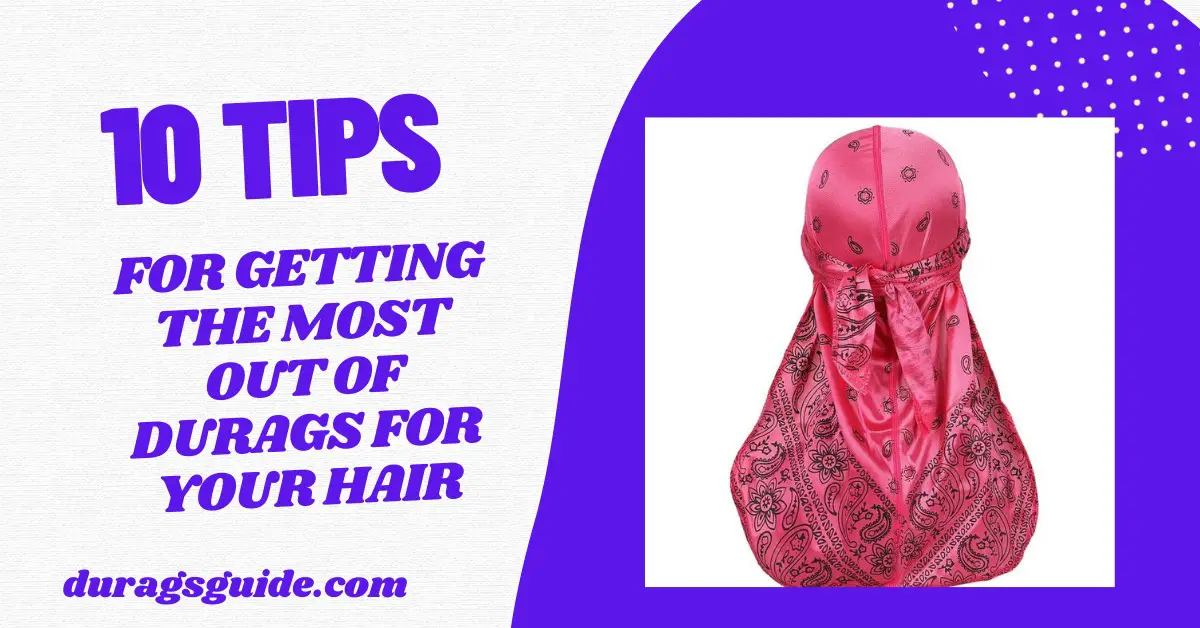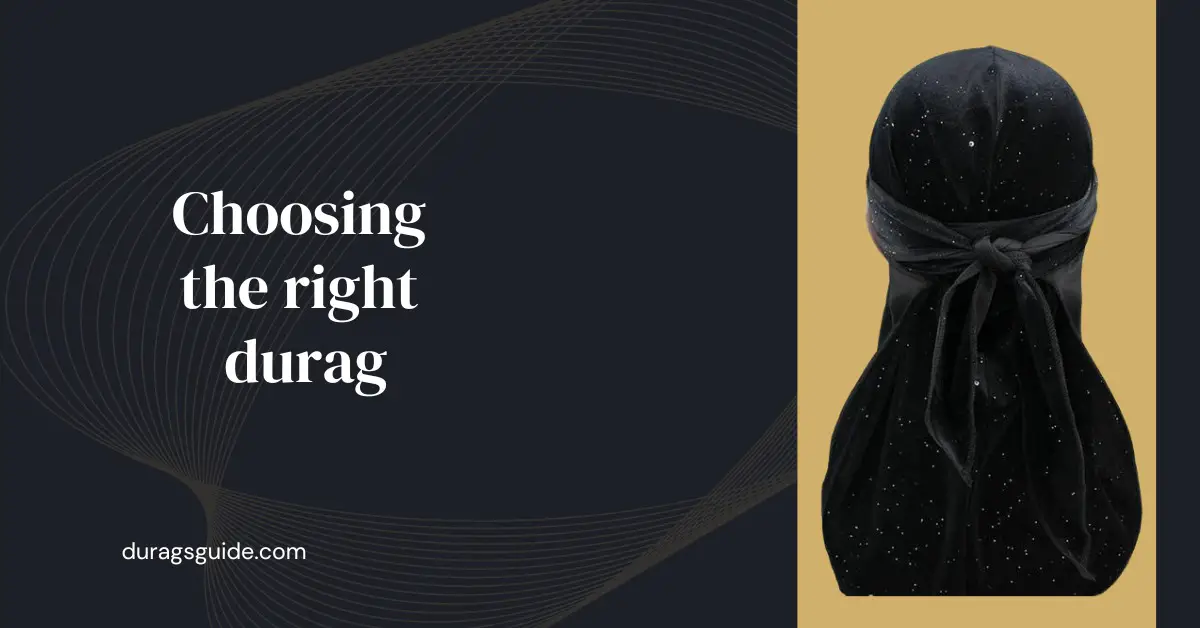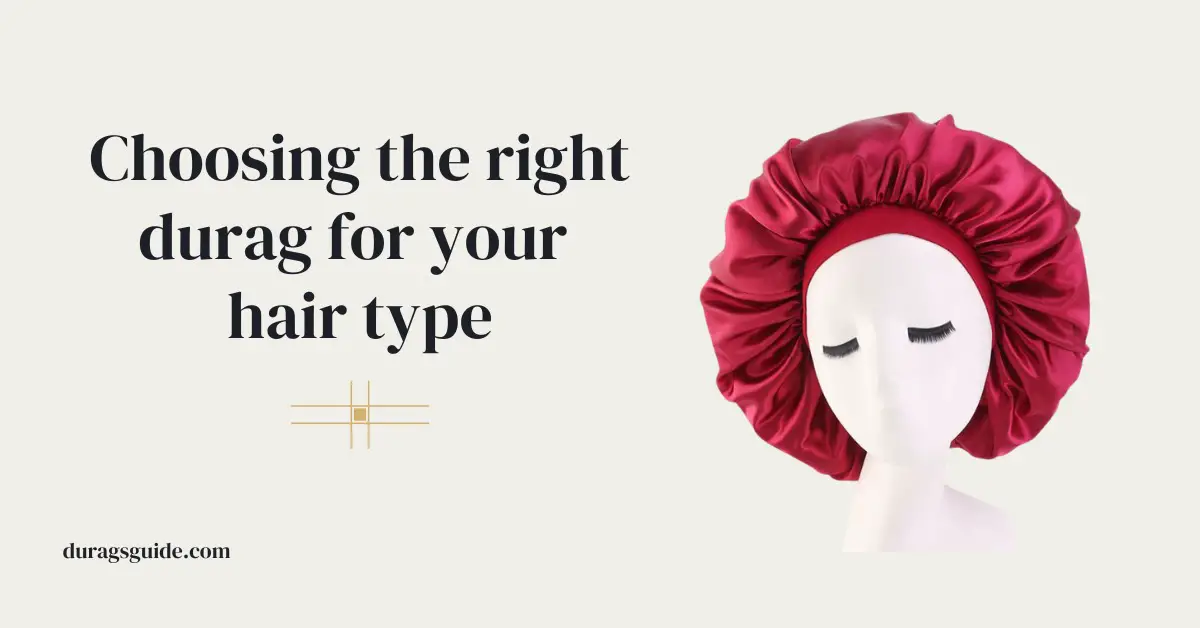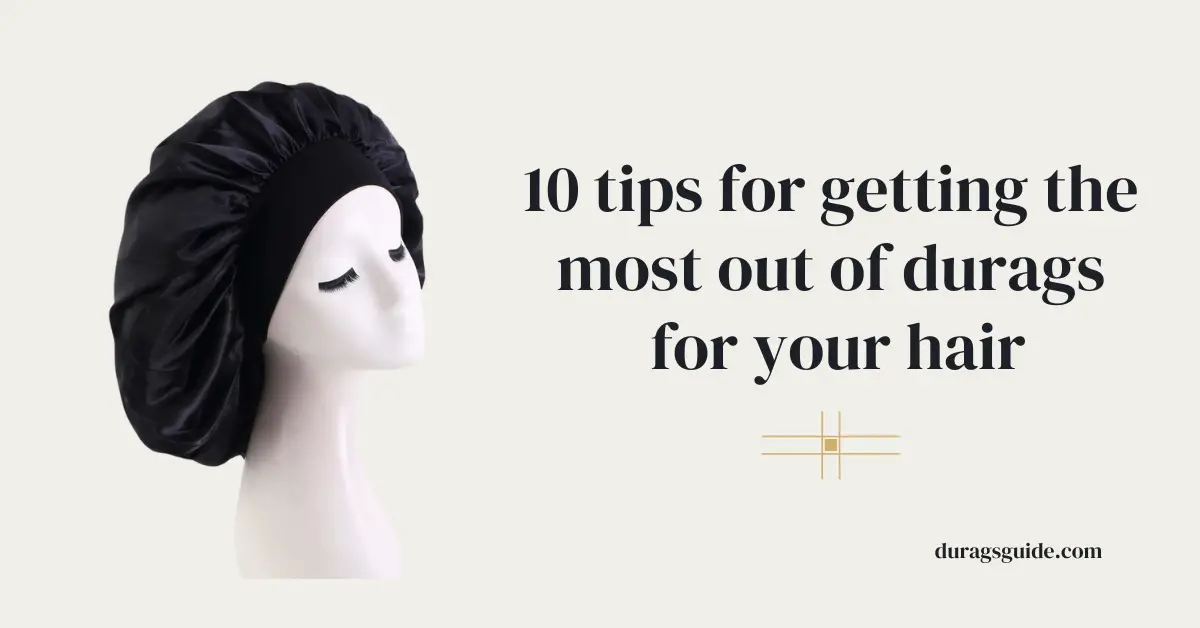Introduction:
Discover the secrets to getting the most out of your durags for healthy, stylish hair. From choosing the right fit to mastering different styles, these tips will elevate your durag game and keep your hair looking its best. Whether you’re a seasoned durag wearer or new to the trend, this guide will help you make the most of this versatile accessory with 10 Tips for Getting the Most Out of Durags for Your Hair.
10 Tips for Getting the Most Out of Durags for Your Hair
| Tip | Description |
| 1. Invest in Quality Durags | Choose durags made from silk or satin for gentler hair care and reduced breakage. |
| 2. Protect Your Hair While Sleeping | Wear a durag at night to prevent friction against your pillowcase, maintaining hairstyles and reducing tangles. |
| 3. Moisturize Before Wearing | Apply leave-in conditioner or oil before donning your durag to lock in moisture throughout the day. |
| 4. Wrap Your Hair Securely | Tie your durag snugly but not too tight to lay down hair smoothly without discomfort. |
| 5. Use Durags for Deep Conditioning | Enhance deep conditioning treatments by wearing a durag to trap heat and boost product effectiveness. |
| 6. Avoid Extended Wear | Take breaks from wearing durags to prevent excessive compression and potential damage to your hairline. |
| 7. Clean Your Durags Regularly | Wash your durags frequently to remove dirt, oils, and product buildup, ensuring healthy hair and scalp. |
| 8. Experiment with Different Styles | Explore various tying techniques and durag colors/patterns to express your style and achieve different looks. |
| 9. Combine with Other Accessories | Pair your durag with hair clips or headbands for added flair while still protecting your hair. |
| 10. Embrace as a Versatile Tool | Utilize durags not only for hairstyling but also as a practical accessory for heat protection and product setting. |
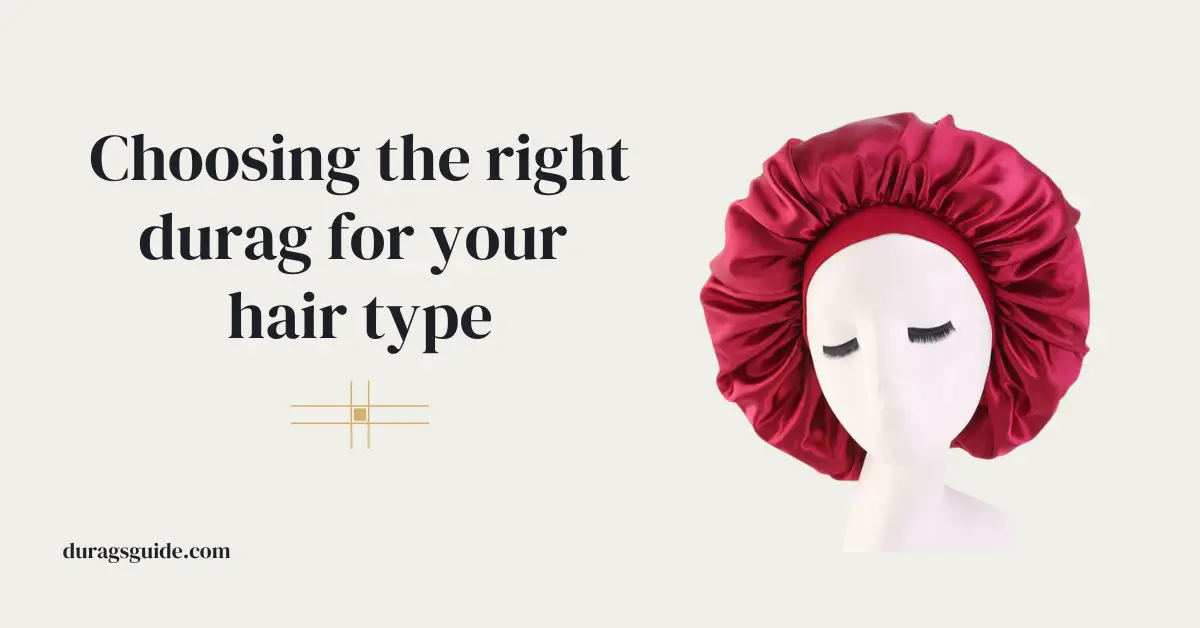
Choosing the Right Durag
1.1 Understanding Different Materials:
- Consider the material of the durag carefully, as it can impact comfort and effectiveness.
- Satin durags are gentle on hair and skin, reducing friction and preventing breakage.
- Velvet durags offer a luxurious feel and are ideal for protecting delicate hairstyles.
1.2 Finding the Perfect Fit:
- Ensure the durag fits snugly but comfortably around your head to maximize effectiveness.
- Adjustable straps and stretchy materials can help achieve the perfect fit for any head size.
- Avoid durags that are too tight, as they can cause discomfort and headaches.
1.3 Considering Durability:
- Look for durags made from high-quality materials that can withstand regular wear and washing.
- Reinforced stitching and durable construction will ensure your durag lasts
- longer.
1.4 Exploring Different Styles:
- Experiment with different styles and designs to find what works best for your hair type and personal preference.
- From classic tie-back styles to more intricate designs, there’s a durag style for every occasion.
1.5 Checking for Breathability:
- Choose durags with breathable materials to prevent excessive heat and sweat buildup.
- Breathable durags allow air circulation, keeping your scalp cool and comfortable throughout the day.
1.6 Considering Hair Length and Texture:
- Take your hair length and texture into account when choosing a durag style.
- Longer hair may require a longer tail for optimal coverage and protection.
1.7 Evaluating Cost and Value:
- Consider the cost of the durag in relation to its quality and features.
- Investing in a higher-quality durag may yield better results and longer-lasting wear.
1.8 Reading Reviews and Recommendations:
- Research customer reviews and seek recommendations from others who wear durags.
- Real-life experiences can provide valuable insights into the performance and durability of different durag brands.
1.9 Trying Before Buying:
- If possible, try on different durags before making a purchase to ensure the best fit and comfort.
- Some stores may allow you to test the fit and feel of durags before committing to a purchase.
1.10 Seeking Professional Advice:
- Consult with a hairstylist or barber for personalized recommendations on durag selection and styling techniques.
- Professionals can offer expert advice based on your hair type, length, and styling goals.
Choosing the Right Durag Proper Durag Application and Maintenance
2.1 Preparing Your Hair:
- Before applying the durag, ensure your hair is clean and free from tangles or knots.
- Use a moisturizing conditioner to hydrate and soften your hair, making it easier to style and maintain under the durag.
2.2 Applying Products:
- Apply a small amount of hair oil or moisturizer to your hair before putting on the durag.
- This helps to seal in moisture and prevent dryness while wearing the durag.
2.3 Securing the Durag:
- Place the durag over your head with the seam at the back, ensuring it covers your entire head.
- Use the straps to adjust the tightness, ensuring a snug but comfortable fit.
2.4 Tieing Techniques:
- Experiment with different tieing techniques to achieve your desired look and level of compression.
- The traditional tie-back method involves folding the tail of the durag up and tying it securely at the back of your head.
2.5 Avoiding Over-tightening:
- Be careful not to tie the durag too tightly, as this can cause discomfort and may lead to headaches.
- Adjust the tightness as needed to ensure comfort without compromising effectiveness.
2.6 Maintenance Tips:
- Remove the durag carefully to avoid pulling or tugging on your hair.
- Wash your durag regularly to remove dirt, oil, and product buildup.
- Follow the care instructions provided by the manufacturer to ensure the durability and longevity of your durag.
2.7 Drying Your Durag:
- Allow your durag to air dry after washing, avoiding direct heat sources like hairdryers.
- This helps to preserve the integrity of the fabric and prevent shrinkage or damage.
2.8 Storing Your Durag:
- Store your durag in a clean, dry place when not in use to prevent it from accumulating dust or dirt.
- Consider investing in a durag rack or storage bag to keep your durags organized and protected.
2.9 Replacing When Necessary:
- Keep an eye on signs of wear and tear, such as frayed edges or loose stitching.
- Replace your durag as needed to ensure optimal performance and comfort.
2.10 Consistency is Key:
- Make durag-wearing a consistent part of your hair care routine to reap the full benefits.
- Consistency in application and maintenance will help you achieve and maintain healthy, well-protected hair.
Choosing the Right Durag Material and Style
3.1 Understanding Durag Materials:
- Cotton: Cotton durags are breathable and absorbent, making them suitable for everyday wear. They are comfortable and easy to wash but may lose their shape over time.
- Satin: Satin durags are smooth and silky, ideal for protecting delicate hair textures. They minimize friction and help retain moisture in the hair. However, they may slip more easily than cotton durags.
- Velvet: Velvet durags offer a luxurious feel and provide extra compression for wave patterns. They are less breathable than cotton or satin but offer superior compression and style retention.
3.2 Considering Durag Styles:
- Standard: Standard durags feature a simple design with a long tail for tieing at the back of the head. They provide adequate compression and coverage for most hair types.
- Extra-Long Tail: Durags with an extra-long tail offer additional length for versatile tieing styles. They allow for more coverage and customization in tieing techniques.
- Two-Tone or Patterned: Two-tone or patterned durags add a stylish twist to traditional designs. They allow for individual expression and can complement different outfits and personal preferences.
3.3 Assessing Hair Needs:
- Hair Texture: Consider your hair texture when selecting a durag material. Cotton durags are suitable for most hair types, while satin or velvet durags are better for delicate or curly hair.
- Desired Compression: Determine how much compression you need based on your hair goals. Velvet durags offer the most compression, making them ideal for enhancing wave patterns or laying down coarse hair.
3.4 Personal Style Preferences:
- Color and Design: Choose a durag color and design that reflects your personal style and complements your wardrobe. Neutral colors like black, navy, or gray are versatile options, while bold colors or patterns make a statement.
- Size and Fit: Ensure the durag fits comfortably without feeling too tight or restrictive. Adjustable straps and stretchy materials can accommodate different head sizes and shapes.
3.5 Durability and Maintenance:
- Consider the durability and maintenance requirements of different durag materials. Cotton durags are easy to wash and maintain but may shrink over time. Satin and velvet durags require more delicate care to preserve their appearance and texture.
3.6 Trying Different Options:
- Experiment with different durag materials, styles, and colors to find what works best for you. Consider purchasing a variety of durags to rotate based on your mood, outfit, or hair care needs.
- Don’t be afraid to step out of your comfort zone and try new styles or designs to elevate your durag game and enhance your hair care routine.
Choosing the Right Durag Material and Style
Proper Durag Application Techniques
4.1 Preparing Your Hair:
- Before putting on a durag, ensure that your hair is clean and moisturized. Use a moisturizing conditioner or hair oil to hydrate your hair and scalp.
- Comb or brush your hair to remove any tangles or knots. Smooth down your hair to create a neat and even base for the durag.
4.2 Placing the Durag:
- Hold the durag with the center seam facing up and the long tail hanging down behind you.
- Position the durag over your head, ensuring that the front edge sits just above your eyebrows.
- Pull the durag back until it covers your hairline and sits snugly against your head.
4.3 Tying the Durag:
- Take the two ends of the durag’s long tail and cross them over at the back of your head.
- Pull the ends tightly to create a secure knot, ensuring that the durag fits comfortably without feeling too tight or restrictive.
- Adjust the position of the durag to ensure that it covers your hairline evenly and provides adequate compression for your hair.
4.4 Securing the Knot:
- Once you have tied the knot, tuck any excess fabric or loose ends underneath the durag to create a clean and neat appearance.
- Ensure that the knot is secure but not overly tight, as this can cause discomfort or headaches.
4.5 Checking for Comfort:
- After tying the durag, take a moment to ensure that it feels comfortable and secure on your head. Adjust the fit if necessary to alleviate any tightness or discomfort.
- Move your head from side to side and up and down to ensure that the durag stays in place and does not slip or shift during wear.
4.6 Final Touches:
- Once the durag is securely in place, use your fingers to adjust any folds or wrinkles in the fabric to create a smooth and uniform appearance.
- Check your hairline and edges to ensure that they are fully covered by the durag, providing maximum protection and compression for your hair.
Proper Durag Application Techniques
Maintainning of durag
5.3 Maintaining Durag Elasticity:
- Over time, the elastic band of the durag may lose its elasticity, leading to a loose fit and decreased effectiveness in holding down hair.
- To maintain the elasticity of your durag, avoid stretching the elastic band excessively when putting it on or taking it off.
- Consider washing your durag with fabric softener to help preserve the elasticity of the elastic band.
- If the elastic band becomes too loose, you can replace it with a new elastic band or sew in a new one to restore its snug fit.
5.4 Avoiding Over-Tightening:
- While a snug fit is important for effective compression and wave formation, over-tightening your durag can lead to discomfort and potential damage to your hairline.
- Be mindful of how tightly you tie your durag to avoid putting excessive pressure on your scalp and hair.
- Opt for durags with adjustable straps or bands that allow you to customize the fit to your comfort level without causing excessive tightness.
5.5 Drying Your Durag Properly:
- After washing your durag, avoid wringing or twisting the fabric to remove excess water, as this can cause stretching and damage to the fabric.
- Instead, gently squeeze out the water and pat the durag dry with a clean towel to absorb remaining moisture.
- Allow the durag to air dry completely before wearing it again to prevent mildew and odors from developing in the fabric.
5.6 Refreshing Your Durag:
- To keep your durag smelling fresh between washes, consider using a fabric refresher spray or lightly spritzing it with a mixture of water and your favorite essential oils.
- Hang your durag in a well-ventilated area to allow it to air out and dry completely before wearing it again.
- Avoid using strong-smelling products or perfumes on your durag, as these can be overpowering and irritating to the skin.
Styling with Durags:
6.1 Accessorizing Durags:
- Durags can be accessorized to match different outfits or personal styles. Consider adding pins, patches, or decorative elements to your durag for a unique look.
- Experiment with different colors and patterns of durags to complement your clothing or express your individuality.
6.2 Durags for Fashion:
- Durags are not only functional but also fashionable accessories. They can be worn as part of a trendy streetwear ensemble or as a statement piece.
- Incorporate durags into your wardrobe by pairing them with casual or athleisure outfits for a stylish and urban-inspired look.
6.3 Styling Durags for Special Occasions:
- Durags can be styled for special occasions such as parties, weddings, or formal events. Opt for silk or satin durags in elegant colors for a sophisticated and polished appearance.
- Experiment with different tying techniques to achieve various styles, such as the traditional wave cap style or a more casual and relaxed look.
6.4 Durags as Hair Accessories:
- Durags can serve as versatile hair accessories, helping to protect hairstyles or keep hair in place during physical activities.
- Use durags to secure braids, twists, or other protective styles, ensuring they stay intact and frizz-free throughout the day.
6.5 Durags for Cultural Expression:
- Durags hold cultural significance for many individuals and communities, representing identity, heritage, and pride.
- Embrace the cultural significance of durags by incorporating them into your style as a form of self-expression and empowerment.
6.6 Celebrity Style Inspiration:
- Look to celebrities and influencers for style inspiration when wearing durags. Many public figures embrace durags as fashion statements and incorporate them into their signature looks.
- Follow your favorite celebrities on social media or search for style inspiration online to discover new ways to rock the durag trend.
Styling with Durags
Durag Maintenance and Care:
7.1 Cleaning Regularly:
- To maintain hygiene and prolong the lifespan of your durags, it’s essential to clean them regularly. Follow the manufacturer’s instructions for washing, whether it’s hand washing or machine washing.
- Use a gentle detergent and lukewarm water to clean your durags, avoiding harsh chemicals or bleach that could damage the fabric.
7.2 Drying Properly:
- After washing, allow your durags to air dry thoroughly. Avoid wringing them out, as this can cause wrinkles or damage the fabric.
- Hang your durags in a well-ventilated area away from direct sunlight to prevent fading and ensure they dry completely.
7.3 Ironing if Necessary:
- If your durags become wrinkled after washing, you can iron them on a low heat setting to smooth out any creases. Be sure to check the fabric care instructions to avoid damaging the material.
- Use a pressing cloth or a thin towel between the iron and the durag to protect delicate fabrics like silk or satin.
7.4 Storing Properly:
- When not in use, store your clean and dry durags in a clean, dry place to prevent dust or dirt buildup.
- Consider investing in a durag rack or organizer to keep your collection organized and easily accessible.
7.5 Replacing When Necessary:
- Over time, durags may become worn out or lose their elasticity, especially with frequent use. Inspect your durags regularly for signs of damage, such as fraying edges or stretched-out elastic.
- Replace worn-out durags promptly to maintain the effectiveness of your hair care routine and prevent discomfort or irritation.
7.6 Avoiding Sharing Durags:
- To prevent the spread of bacteria or skin infections, avoid sharing your durags with others. Each person should have their own durag for personal use.
- If you need to share a durag with someone, make sure it’s properly cleaned and sanitized between uses to minimize the risk of contamination.
Choosing the Right Durag for Your Hair Type:
8.1 Consider Fabric and Material:
- Different hair types may benefit from specific durag fabrics. For example, silk and satin durags are gentle on delicate hair types like curly or textured hair, reducing friction and preventing breakage.
- Cotton durags are breathable and absorbent, making them suitable for all hair types, including those prone to excess moisture or oil.
8.2 Assess Durability and Elasticity:
- Durags with strong, durable stitching and elastic bands are essential for securing the durag in place without causing discomfort or slipping throughout the day or night.
- Look for durags with reinforced stitching along the edges to prevent fraying and ensure longevity, especially with frequent use.
8.3 Consider Hair Length and Volume:
- Longer or thicker hair may require larger or longer durags to accommodate the volume and prevent compression or flattening of the hair.
- Consider the size and shape of your head when selecting a durag to ensure a comfortable fit that covers your hair completely without feeling too tight or restrictive.
8.4 Evaluate Breathability and Comfort:
- Opt for durags made from breathable materials that allow air circulation to prevent overheating and discomfort, particularly during warmer weather or prolonged wear.
- Soft, lightweight fabrics like silk or satin provide a comfortable feel against the skin and reduce irritation or itching, making them ideal for sensitive scalps.
8.5 Choose Colors and Patterns Wisely:
- Durags come in a variety of colors and patterns, allowing you to express your personal style while protecting your hair.
- Consider choosing darker colors or patterns that complement your wardrobe and lifestyle while hiding potential stains or discoloration from everyday wear.
8.6 Experiment with Different Styles:
- Don’t be afraid to try out different styles and designs of durags to find the perfect fit and look for your hair type and personal preferences.
- Explore options like long-tail durags for extra compression and coverage, or wave caps for creating and maintaining waves or curls in your hair.
Choosing the Right Durag for Your Hair Type: 10 Tips for Getting the Most Out of Durags for Your Hair
Durags have become an essential accessory for many individuals, especially those with textured or curly hair. Not only do they serve as a fashion statement, but they also play a crucial role in maintaining healthy hair and achieving various hairstyles. Here are ten tips to help you maximize the benefits of using durags:
- Invest in Quality Durags: Opt for durags made from high-quality materials like silk or satin. These materials are gentle on your hair, reducing friction and preventing breakage.
- Protect Your Hair While Sleeping: Wear a durag at night to protect your hair from friction against your pillowcase. This helps maintain your hairstyle for longer and prevents tangles and frizz.
- Moisturize Before Wearing: Apply a leave-in conditioner or hair oil before putting on your durag. This helps lock in moisture and keeps your hair hydrated throughout the day.
- Wrap Your Hair Securely: Ensure that your durag is tied securely but not too tightly. A snug fit helps lay down your hair smoothly without causing discomfort or headaches.
- Use Durags for Deep Conditioning: Apply a deep conditioning treatment to your hair and then wear a durag to trap heat and enhance the product’s effectiveness. This promotes hydration and strengthens your hair strands.
- Avoid Wearing Durags for Extended Periods: While durags are beneficial for protecting your hair, wearing them for too long can lead to excessive compression and potential damage to your hairline. Take breaks and allow your scalp to breathe.
- Clean Your Durags Regularly: Regularly wash your durags to remove dirt, oils, and product buildup. Clean durags are essential for maintaining healthy hair and preventing bacterial growth.
- Experiment with Different Styles: Durags come in various colors and patterns, allowing you to express your style and switch up your look effortlessly. Experiment with different tying techniques to achieve various hairstyles.
- Combine Durags with Other Hair Accessories: Pair your durag with other hair accessories like hair clips or headbands to create unique and fashionable looks while still protecting your hair.
- Embrace Durags as a Versatile Hair Tool: Durags are not only for maintaining hairstyles but can also be used as a styling tool. Use them to set your hair in place while applying heat or styling products.
Pros:
- Provides protection for your hair, especially at night, reducing breakage and frizz.
- Helps maintain hairstyles for longer periods.
- Enhances the effectiveness of deep conditioning treatments.
- Can be styled in various ways to match your outfit or mood.
- Allows for experimentation with different hair care techniques.
- Promotes healthy hair by keeping it moisturized and reducing damage from friction.
- Versatile accessory that can be worn for fashion or practical purposes.
Cons:
- Prolonged wear may lead to discomfort or potential damage to the hairline.
- Regular cleaning is necessary to prevent dirt and bacteria buildup.
- Quality durags made from silk or satin can be expensive.
- Requires some skill to tie securely without causing tension headaches.
- Not suitable for all hair types or styles, may not be suitable for those with very short hair.
10 Tips for Getting the Most Out of Durags for Your Hair
Conclusion
In conclusion, incorporating durags into your hair care routine can significantly benefit the health and style of your hair. By following these ten tips, you can maximize the advantages of using durags, from protecting your hair while sleeping to enhancing deep conditioning treatments and experimenting with various styles. Remember to invest in quality durags, prioritize hair hydration, and maintain cleanliness for optimal results. Embrace durags not only as a practical tool for maintaining hairstyles but also as a versatile accessory to express your unique sense of style. With proper care and attention, durags can become an essential part of your hair care regimen, promoting healthy, beautiful hair day after day.
FAQS
How to use durag for hair growth?
To use a durag for hair growth, ensure it's made of breathable material like silk to minimize friction, tie it snugly to promote blood circulation, and maintain a consistent hair care routine with moisturizing products to encourage healthy growth.
What to put on hair before durag?
Before putting on a durag, apply a small amount of leave-in conditioner or moisturizing hair cream to keep your hair hydrated and prevent dryness. Avoid using heavy products that may weigh down your hair or leave residue on the durag fabric.
How to tie a Durag with Short strings?
When tying a durag with short strings, start by placing the center of the durag at the back of your head. Cross the strings over each other at the front, then bring them around to the back and tie them tightly into a knot or bow, securing the durag in place. Adjust the fit as needed to ensure comfort and proper coverage.
How to tie a Durag without the Tail?
To tie a durag without the tail, position the center of the durag at the back of your head. Cross the strings over each other at the front, then wrap them around to the back and tie them securely into a knot or bow, ensuring a snug fit without the tail hanging down. Adjust as needed for comfort and style.
How to tie a durag step by step?
To tie a durag, start by placing the center of the durag at the back of your head. Cross the strings over each other at the front, wrap them around to the back, and tie them securely into a knot or bow, ensuring a snug fit for your hair. Adjust for comfort and style.
